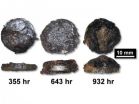(Press-News.org) UPTON, NY-Scientists at the U.S. Department of Energy's (DOE) Brookhaven National Laboratory have discovered a new catalytic system for converting carbon dioxide (CO2) to methanol-a key commodity used to create a wide range of industrial chemicals and fuels. With significantly higher activity than other catalysts now in use, the new system could make it easier to get normally unreactive CO2 to participate in these reactions.
"Developing an effective catalyst for synthesizing methanol from CO2 could greatly expand the use of this abundant gas as an economical feedstock," said Brookhaven chemist Jose Rodriguez, who led the research. It's even possible to imagine a future in which such catalysts help mitigate the accumulation of this greenhouse gas, by capturing CO2 emitted from methanol-powered combustion engines and fuel cells, and recycling it to synthesize new fuel.
That future, of course, will be determined by a variety of factors, including economics. "Our basic research studies are focused on the science-the discovery of how such catalysts work, and the use of this knowledge to improve their activity and selectivity," Rodriguez emphasized.
The research team, which included scientists from Brookhaven, the University of Seville in Spain, and Central University of Venezuela, describes their results in the August 1, 2014, issue of the journal Science.
New tools for discovery
Because CO2 is normally such a reluctant participant in chemical reactions, interacting weakly with most catalysts, it's also rather difficult to study. These studies required the use of newly developed in-situ (or on-site, meaning under reaction conditions) imaging and chemical "fingerprinting" techniques. These techniques allowed the scientists to peer into the dynamic evolution of a variety of catalysts as they operated in real time. The scientists also used computational modeling at the University of Seville and the Barcelona Supercomputing Center to provide a molecular description of the methanol synthesis mechanism.
The team was particularly interested in exploring a catalyst composed of copper and ceria (cerium-oxide) nanoparticles, sometimes also mixed with titania. The scientists' previous studies with such metal-oxide nanoparticle catalysts have demonstrated their exceptional reactivity in a variety of reactions. In those studies, the interfaces of the two types of nanoparticles turned out to be critical to the reactivity of the catalysts, with highly reactive sites forming at regions where the two phases meet.
To explore the reactivity of such dual particle catalytic systems in converting CO2 to methanol, the scientists used spectroscopic techniques to investigate the interaction of CO2 with plain copper, plain cerium-oxide, and cerium-oxide/copper surfaces at a range of reaction temperatures and pressures. Chemical fingerprinting was combined with computational modeling to reveal the most probable progression of intermediates as the reaction from CO2 to methanol proceeded.
These studies revealed that the metal component of the catalysts alone could not carry out all the chemical steps necessary for the production of methanol. The most effective binding and activation of CO2 occurred at the interfaces between metal and oxide nanoparticles in the cerium-oxide/copper catalytic system.
"The key active sites for the chemical transformations involved atoms from the metal [copper] and oxide [ceria or ceria/titania] phases," said Jesus Graciani, a chemist from the University of Seville and first author on the paper. The resulting catalyst converts CO2 to methanol more than a thousand times faster than plain copper particles, and almost 90 times faster than a common copper/zinc-oxide catalyst currently in industrial use.
This study illustrates the substantial benefits that can be obtained by properly tuning the properties of a metal-oxide interface in catalysts for methanol synthesis.
"It is a very interesting step, and appears to create a new strategy for the design of highly active catalysts for the synthesis of alcohols and related molecules," said Brookhaven Lab Chemistry Department Chair Alex Harris.
INFORMATION:
The work at Brookhaven Lab was supported by the DOE Office of Science. The studies performed at the University of Seville were funded by the Ministerio de Economía y Competitividad of Spain and the European Regional Development Fund. The Instituto de Tecnologia Venezolana para el Petroleo supported part of the work carried out at the Central University of Venezuela.
Brookhaven National Laboratory is supported by the Office of Science of the U.S. Department of Energy. The Office of Science is the single largest supporter of basic research in the physical sciences in the United States, and is working to address some of the most pressing challenges of our time. For more information, please visit science.energy.gov.
One of ten national laboratories overseen and primarily funded by the Office of Science of the U.S. Department of Energy (DOE), Brookhaven National Laboratory conducts research in the physical, biomedical, and environmental sciences, as well as in energy technologies and national security. Brookhaven Lab also builds and operates major scientific facilities available to university, industry and government researchers. Brookhaven is operated and managed for DOE's Office of Science by Brookhaven Science Associates, a limited-liability company founded by the Research Foundation for the State University of New York on behalf of Stony Brook University, the largest academic user of Laboratory facilities, and Battelle, a nonprofit applied science and technology organization.
Visit Brookhaven Lab's electronic newsroom for links, news archives, graphics, and more at http://www.bnl.gov/newsroom, follow Brookhaven Lab on Twitter, http://twitter.com/BrookhavenLab, or find us on Facebook, http://www.facebook.com/BrookhavenLab/.
Nanostructured metal-oxide catalyst efficiently converts CO2 to methanol
Highly reactive sites at interface of 2 nanoscale components could help overcome hurdle of using CO2 as a starting point in producing useful products
2014-07-31
ELSE PRESS RELEASES FROM THIS DATE:
Refocusing research into high-temperature superconductors
2014-07-31
Below a specific transition temperature superconductors transmit electrical current nearly loss-free. For the best of the so-called high-temperature superconductors, this temperature lies around -180 °C – a temperature that can be achieved by cooling with liquid nitrogen.
The location of atomic nuclei and binding electrons in a material is determined by its crystal structure. However, electrons additionally have an electromagnetic angular momentum, referred to as spin. When many spins become coupled in a material, electromagnetic disturbances with a preferential orientation ...
Study finds benefits to burning Flint Hills prairie in fall and winter
2014-07-31
MANHATTAN — Kansas State University researchers have completed a 20-year study that looks at the consequences of burning Flint Hills prairie at different times of the year. It finds that burning outside of the current late spring time frame has no measurable negative consequences for the prairie and, in fact, may have multiple benefits.
The study was conducted by Gene Towne, research associate and the Konza Prairie Biological Station fire chief, and Joseph Craine, research assistant professor, both in the Division of Biology. They recently published the study, "Ecological ...
Fermi satellite detects gamma-rays from exploding novae
2014-07-31
TEMPE, Ariz. - The Universe is home to a variety of exotic objects and beautiful phenomena, some of which can generate almost inconceivable amounts of energy. ASU Regents' Professor Sumner Starrfield is part of a team that used the Large Area Telescope (LAT) onboard NASA's Fermi Gamma-ray Space Telescope satellite to discover very high energy gamma rays (the most energetic form of light) being emitted by an exploding star. The surprising discovery dispels the long-held idea that classical nova explosions are not powerful enough to produce such high-energy radiation.
In ...
NASA sees Genevieve squeezed between 3 tropical systems
2014-07-31
The resurrected Tropical Depression Genevieve appears squeezed between three other developing areas of low pressure. Satellite data from NOAA and NASA continue to show a lot of tropical activity in the Eastern and Central Pacific Oceans on July 31.
NASA/NOAA's GOES Project at the NASA Goddard Space Flight Center in Greenbelt, Maryland has been kept busy, providing visible and infrared satellite imagery of the Eastern and Central Pacific Oceans. The project uses data from NOAA's GOES-West and GOES-East satellites to create images and animations. All four systems were captured ...
CU Denver study links self-identified ethnic labels to cultural values
2014-07-31
DENVER (July 31, 2014) – A recently released study by a researcher at the University of Colorado Denver and published in the Journal of Humanistic Counseling explores why people of Latin American descent self-identify using terms like Latina/o, Hispanic, and Chicana/o. Carlos Hipolito-Delgado, an associate professor in the School of Education & Human Development at the University of Colorado Denver, found a difference between preferred ethnic labels and how a person identifies with their cultural heritage and United States values.
An expert in ethnic identity development, ...
Carnegie Mellon chemists create nanofibers using unprecedented new method
2014-07-31
PITTSBURGH—Researchers from Carnegie Mellon University have developed a novel method for creating self-assembled protein/polymer nanostructures that are reminiscent of fibers found in living cells. The work offers a promising new way to fabricate materials for drug delivery and tissue engineering applications. The findings were published in the July 28 issue of Angewandte Chemie International Edition.
"We have demonstrated that, by adding flexible linkers to protein molecules, we can form completely new types of aggregates. These aggregates can act as a structural material ...
Groundbreaking research maps cultural history
2014-07-31
New research from Northeastern University has mapped the intellectual migration network in North America and Europe over a 2,000-year span. The team of network scientists used the birth and death locations of more than 150,000 intellectuals to map their mobility patterns in order to identify the major cultural centers on the two continents over two millennia.
In the new paper, to be published Friday in the journal Science, the researchers found how locations such as Rome, London, and Paris have emerged as cultural hubs as more intellectuals died in these cities than ...
NIST corrosion lab tests suggest need for underground gas tank retrofits
2014-07-31
A hidden hazard lurks beneath many of the roughly 156,000 gas stations across the United States.
The hazard is corrosion in parts of underground gas storage tanks—corrosion that could result in failures, leaks and contamination of groundwater, a source of drinking water. In recent years, field inspectors in nine states have reported many rapidly corroding gas storage tank components such as sump pumps. These incidents are generally associated with use of gasoline-ethanol blends and the presence of bacteria, Acetobacter aceti, which convert ethanol to acetic acid, a component ...
New bipartisan House bill draws on U-M health research
2014-07-31
ANN ARBOR—A new bill introduced in Congress with bipartisan support would allow Medicare to test a concept born from University of Michigan research, which could improve the health of patients with chronic illness while reducing what they spend on the medicines and tests they need most.
The bill, introduced last week by U.S. Reps. Diane Black and Earl Blumenauer, grew out of a decade of work by health policy researchers affiliated with the U-M's Institute for Healthcare Policy and Innovation. It would allow Medicare Advantage plans to use innovative "value-based" insurance ...
Parenting skills improve in ADHD parents with medication
2014-07-31
Parenting skills of adults with ADHD improve when their ADHD is treated with medication, according to Penn State College of Medicine researchers.
At least 25 percent of clinic-referred children with attention deficit/hyperactivity disorder have a parent with ADHD.
"Parents with ADHD are at increased risk to engage in problematic parenting techniques, including inconsistent disciplinary practices, making ineffectual commands and diminished use of praise," said James Waxmonsky, associate professor of psychiatry. "Having a parent with ADHD also decreases the chances that ...
LAST 30 PRESS RELEASES:
University of Oklahoma researcher awarded funding to pursue AI-powered material design
Exploring how the visual system recovers following injury
Support for parents with infants at pediatric check-ups leads to better reading and math skills in elementary school
Kids’ behavioral health is a growing share of family health costs
Day & night: Cancer disrupts the brain’s natural rhythm
COVID-19 vaccination significantly reduces risk to pregnant women and baby
The role of vaccination in maternal and perinatal outcomes associated with COVID-19 in pregnancy
Mayo Clinic smartwatch system helps parents shorten and defuse children's severe tantrums early
Behavioral health spending spikes to 40% of all children’s health expenditures, nearly doubling in a decade
Digital cognitive behavioral treatment for generalized anxiety disorder
Expenditures for pediatric behavioral health care over time and estimated family financial burden
Air conditioning in nursing homes and mortality during extreme heat
The Alps to lose a record number of glaciers in the next decade
What makes a good proton conductor?
New science reporting guide published for journalists in Bulgaria
New international study reveals major survival gaps among children with cancer
New science reporting guide published for journalists in Turkey
Scientists develop a smarter mRNA therapy that knows which cells to target
Neuroanatomy-informed brain–machine hybrid intelligence for robust acoustic target detection
Eight SwRI hydrogen projects funded by ENERGYWERX
The Lundquist Institute and its start-up company Vitalex Biosciences Announces Strategic Advancement of Second-Generation fungal Vaccine VXV-01 through Phase 1 Trials under $40 Million Competitive Con
Fine particles in pollution are associated with early signs of autoimmune disease
Review article | Towards a Global Ground-Based Earth Observatory (GGBEO): Leveraging existing systems and networks
Penn and UMich create world’s smallest programmable, autonomous robots
Cleveland researchers launch first major study to address ‘hidden performance killer’ in athletes
To connect across politics, try saying what you oppose
Modulating key interaction prevents virus from entering cells
Project explores barriers to NHS career progression facing international medical graduates
Jeonbuk National University researchers explore the impact of different seasonings on the flavor perception of Doenjang soup
Two Keck Medicine of USC Hospitals named Leapfrog Top Teaching Hospitals
[Press-News.org] Nanostructured metal-oxide catalyst efficiently converts CO2 to methanolHighly reactive sites at interface of 2 nanoscale components could help overcome hurdle of using CO2 as a starting point in producing useful products






